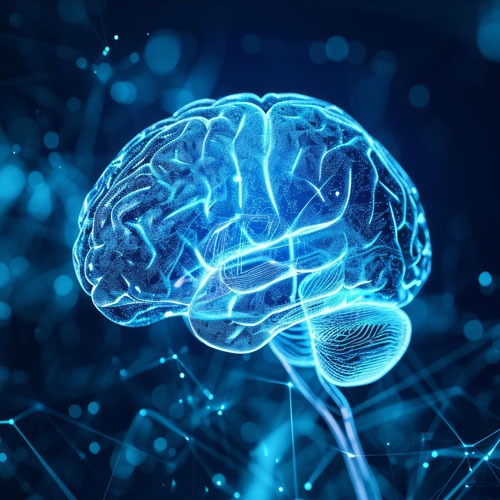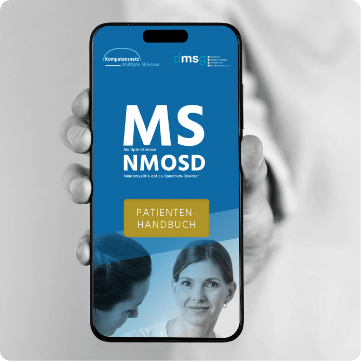About MS – What is multiple sclerosis?
Multiple sclerosis (MS) is an inflammatory disease of the central nervous system that affects more than 200,000 people in Germany. A reaction of the body to its own nerve cells destroys the layer that normally protects nerve tracts and improves their conductivity, the so-called myelin sheaths. The cause of this autoimmune reaction is not yet known. This is why research activities on multiple sclerosis, e.g. at the KKNMS, are so important.
As nerve damage can occur in different areas of the brain and spinal cord, the symptoms of MS are complex: visual disturbances, signs of paralysis, numbness, double vision, dizziness – to name just the most important. Multiple sclerosis is therefore also known as the disease of 1,000 faces. People who are diagnosed with multiple sclerosis are usually between 20 and 40 years old. The course of the disease is very variable and difficult to predict. In addition to disease prediction possibilities in magnetic resonance imaging, work is currently being carried out on blood biomarkers, such as neurofilament.
Even though MS cannot yet be cured, there are now drugs that can be used to reduce the activity and progression of the disease.
Multiple sclerosis is still a mystery
The cause of MS is still unknown. However, many findings suggest that MS is an autoimmune disease in which the body’s own immune cells attack the brain and spinal cord. Research findings to date suggest that genetic factors play a role in the development of the disease, but that environmental influences contribute much more to the triggering of the disease. Although MS is not a classic hereditary disease, most of the genetic risk factors that have been associated with the disease to date have one thing in common: they are genes of the immune system.
Viruses as a trigger?
Various pathogens, in particular viruses and bacteria (e.g. Epstein-Barr virus from the herpes virus group), are suspected of causing multiple sclerosis. It is assumed that the immune cells formed against the pathogen(s) cross-react with proteins in the brain and thus inadvertently attack it. So far, however, no virus or bacterium has been identified as a clear “MS pathogen”.
MS risk increases with higher latitudes
Multiple sclerosis is particularly common in central and northern Europe, North America and southern Australia, while countries with high levels of sunlight, such as Africa and large parts of Asia, are less affected. Researchers therefore suspect a connection with the vitamin D metabolism: vitamin D is formed on the skin via sunlight. Although this connection has already been shown in several scientific studies, it remains unclear whether vitamin D deficiency really plays a causal role in the development of MS.
Lifestyle and gender relations
But lifestyle and diet also influence the onset of the disease. For example, smokers are 1.5 times more likely to develop MS than non-smokers. Interestingly, more women than men are diagnosed with relapsing-remitting MS, the gender ratio is at least 3:1. It is not known why this is the case.
The disease of 1,000 faces
As an inflammatory disease that affects all structures of the nervous system, the symptoms of MS are very diverse and vary over the course of the disease. They usually occur during a flare-up. An episode lasts at least 24 hours. Initial symptoms are usually visual and sensory disturbances such as numbness or pain.
If the motor system is affected, symptoms of paralysis occur. Other symptoms include impaired coordination of movement, rapid fatigue and impaired mental performance (e.g. memory, concentration) and mental disorders.
If the autonomic nervous system is disturbed during a relapse, patients may not be able to control their bladder and bowel functions. It can also lead to sexual dysfunction. Most of the symptoms largely disappear once the flare-up has subsided, but impairments may still remain. Throughout the course of the disease, patients are most often affected by rapid fatigue, bladder dysfunction and paralysis.
The main criterion for the diagnosis of MS is still the detection of spatial and temporal dissemination of inflammatory foci. Doctors understand spatial dissemination to mean that inflammatory foci are present at more than one location in the central nervous system. Temporal dissemination means that new foci develop in the central nervous system during the course of the disease. Suspicion of the presence of MS ultimately arises from the patient interview combined with the physical examination, in which typical symptoms of loss of function must be demonstrated.
Early diagnostic aid: magnetic resonance imaging (MRI)
Magnetic resonance imaging (MRI), which provides tomographic images of the brain and spinal cord, is essential for early diagnosis in particular. MRI can be used to visualize or demonstrate both temporal and spatial dissemination. MRI can also be used to rule out other diagnoses that cause similar symptoms.
The MS diagnosis is rounded off by a laboratory chemical examination of spinal fluid (cerebrospinal fluid). If necessary, electrophysiological examinations, so-called evoked potentials, are also helpful. These targeted stimulations of sensory organs or nerves can be used to detect damage in the nerve pathways of the brain and spinal cord. Blood tests are carried out to rule out other diseases or to clearly differentiate them from multiple sclerosis.
In principle, several diagnostic components are always required for the diagnosis of MS – an MRI scan alone is not enough.
Three-stage therapy model
There is currently no cure for multiple sclerosis. Neurologists currently have a three-stage therapy model at their disposal that takes into account the specific course of the disease:
- Acute relapse therapy
- Progression-modifying therapy
- Symptomatic therapy
Acute relapse therapy
Doctors use cortisone medication to treat acute flare-ups. Cortisone has an anti-inflammatory effect and influences the faster regression of symptoms. It is usually administered intravenously, i.e. by infusion. If it does not have the desired effect, a debilitating acute attack can also be treated with the help of blood washing (plasmapheresis).
Progression-modifying therapy
Various so-called course-modifying drugs are used in MS therapy, which are described in detail in the KKNMS patient handbook.
Symptomatic therapy
Due to the different types of symptoms, a range of other therapeutic measures can be added if necessary: physiotherapy, occupational therapy, speech therapy or psychotherapy. It may also be necessary to take additional medication to treat symptoms such as bladder dysfunction and depression.

MS Brain Bank
Donor program for MS research: Establishment of a German MS Brain Bank
Although MS research has made progress in recent years, the exact mechanisms that lead to tissue damage in multiple sclerosis have not yet been clarified. Examinations of tissue samples from the brain and spinal cord of deceased patients help in the search for the causes of the disease. Our researchers are therefore dependent on your donation.
For this reason, the Disease-Related Competence Network Multiple Sclerosis (KKNMS) has set up its own CNS sample bank (German MS Brain Bank).
Any patient with multiple sclerosis who wishes to support medical research beyond their death can register with the MS donor program. After death, the brain and spinal cord are removed during an autopsy. Although the donors will no longer benefit from the researchers’ new findings, they are laying the foundations for helping other patients in the future.
How does the MS Brain Bank work?
For the KKNMS experts, it is important that the course of the disease is documented during the patient’s lifetime. For this purpose, patients receive a chip card-sized donor card after inclusion in the MS donor program.
If a patient dies, the relatives or the doctor who last treated the patient should contact the Institute of Neuropathology in Göttingen as soon as possible. There, it is ensured that the body is transferred to Göttingen or that the tissue donation is removed by experienced neuropathologists on site. The deceased can then be buried by the relatives. No costs are incurred by the bereaved for the transportation of the body.
If you are interested or have any questions about the KKNMS donor program, please do not hesitate to contact us.

Patient handbook
The virtual patient handbook from KKNMS and DMSG
Information for patients about the available MS drugs
DMSG
Founded in 1952/1953 as an association of medical professionals, the German Multiple Sclerosis Society (DMSG) represents the interests of people with multiple sclerosis and organizes their socio-medical aftercare. The DMSG, with its national association, 16 regional associations and around 800 local contact groups, is a strong community of people with MS, their relatives, almost 4,000 volunteers and 276 full-time employees. The DMSG has a total of almost 43,000 members. With its extensive services and offers, it is today both a self-help and professional association, but also represents the interests of people with MS in Germany.
German Multiple Sclerosis Society Federal Association – DMSG e.V.
Krausenstraße 50, 30171 Hanover
+49 511 9 68 34-0
dmsg@dmsg.de
www.dmsg.de